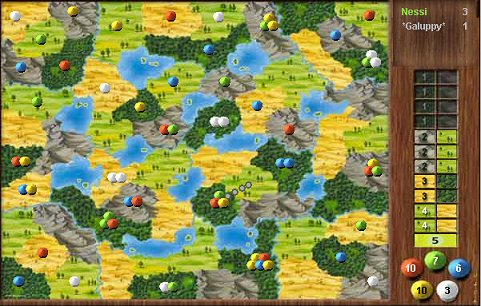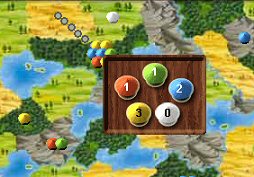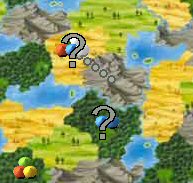Clans
Game preparation
With /join 2-4 players can enter the game. With /start the game begins. Alternatively, you can use the game management use.
The game

Clans is about making villages and as unobtrusive as possible of his own, secret color to score most points.
The field
At the beginning, all huts are randomly distributed on the field, so that exactly one hut stands in each area.

In the right part you can see the bonus points collected by players during the game from top to bottom (the name is displayed in the game color), the display of the completed and still upcoming epochs, as well as the points collected by the clans.
Game sequence
Once the game has been started, your own name will be displayed in the color of the clan you play for. In the game there is only one pull mechanism: All Cabins in an area are drawn to the huts of any neighbouring area, which must therefore not be empty. Rivers can be crossed, but lakes are not. This creates a new empty area with each train, which remains empty until the end of the game.
If a group comprises seven or more huts, it must normally no longer be pulled further, but huts from adjacent areas can still be added to this group. In the rare case that groups with seven or more huts are located in neighbouring areas, the smaller group must be drawn to the larger ones (in the case of equal groups, each of the two can be drawn to the other).
Establishing villages
A group of huts (but also a single hut) becomes a village as soon as after a train its area is only surrounded by empty areas, so that these huts can no longer be moved. For the establishment of a village, the player who made the appropriate train gets a bonus point.
Valuation of villages
The game extends over five epochs, which are shown on the right side of the field. In each of the first four epochs, one of the four landscapes has a particularly beneficial effect in the formation of villages (left-hand landscape, e.g. forest in the first epoch), while another landscape is anti-life (right landscape, e.g. the mountainland in the first epoch). The other landscapes are neutral. In the fifth epoch all landscapes are favorable. The epoch counter on the field also shows how many villages must be founded before the transition to the next epoch takes place (e.g. three villages in the second epoch).
In principle, each clan colour represented in the village gets as many points as there are huts in the village - whether the colour is represented with one or more huts. This applies only if in a newly founded village not all five colors are represented. Are all five colors in the village, there are first disputes and all only once existing cottages are immediately removed from the village. Only the remaining huts come into the classification.
If a village is founded in an area with a favorable landscape, the village also receives as many bonus points as are indicated on the right side of the epoch. If a village is founded in a wild landscape, the clans do not get any points for the village; the bonus point for the village is still available.
Information about online operation
The exact form of the areas is not taken into account when carrying out a train. It is therefore important to move huts to the huts of the target area and not just anywhere in the new area.

Due to the limited space, only up to 19 cabins per area are shown in the field. The exact number of huts in an area can be displayed at any time by clicking the right mouse button in an area (or alternatively: Shift + left mouse button).

If several villages are founded by a train, these are marked by hidden question marks. The player who founded the villages then determines by clicking the order in which these villages are valued; this is often important for the allocation of village foundations to the individual epochs.
Playing
The game is at the moment when the twelfth village is founded or in the rare case that no train is possible before twelve villages have emerged.
The clan colors of the individual players are now uncovered and the players receive the points of their clan in addition to the bonus points previously collected for village formations.

